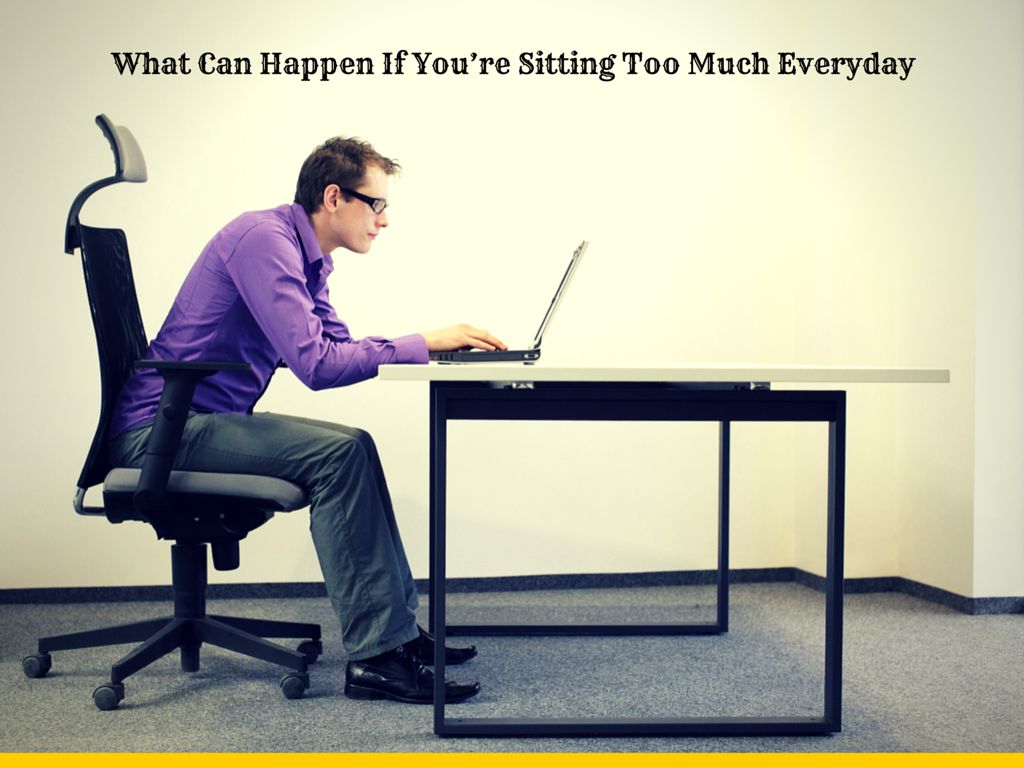What Can Happen If You’re Sitting Too Much Everyday?
This post was last updated on September 4th, 2024

In an entire day of 24 hours we people spend almost 7 hours for sleep, 2 hours for household chores, 1 hour for workout (optional), 1 hour for personal care, 8 hours for office work (also includes sitting) and rest 5 hours in sitting at home reading books, watching Television and gossiping.
So, in total we people spend complete 13 hours in sitting only that is 54 per cent of entire day. Just, imagine we people are spending more than half of the entire day only by sitting, bending our backbone. An average adult spends 50% to 70% of their time sitting down, either at work using computer or watching television at home. Most of the people know that spending too much time in a chair can lead to back, neck and shoulder pain. But there’s more. A new research has found that a sedentary lifestyle has serious health risks and consequences. Sitting too much everyday not only causes pain in back and shoulder but there are many health hazards that you probably have never thought about. Let’s have a look.
1. Causes obesity
Researchers have discovered that the effects of being inactive during time away from work, after five years, those who spent less than 12 hours a week in sitting and more than four hours of workout had a 75% lower obesity risk as compared to those who sit more than 25 hours a week and spent less than 90 minutes for workout. Hence, it was asserted that both high levels of physical activity and low levels of sitting time period can remarkably reduce the risk of obesity.
2. Risk of Type 2 diabetes
Prolonged sitting can cause the body cells to become less responsive to insulin, a condition which is a precursor to the disease. The pancreas produces insulin, a hormone that carries glucose to the cells for energy. But the cells in idle muscles do not respond promptly to insulin, hence, the pancreas produces more and more insulin which can lead to Type 2 diabetes and other diseases.
3. Risk of heart diseases
According to the Medical College of Wisconsin, the risk of developing heart disease rises by 14% for sitting every hour a day. According to the study, the time spent in sitting with levels of coronary artery calcification, an indicator of subclinical heart disease that can increase the risk of heart attack. The researchers found there is no association between coronary artery calcification and the amount of exercise done, as exercise may not check the effects of a sedentary lifestyle with sitting too much everyday. Idle muscles burn less fat and the blood flows more slowly during a long sit which allows fatty acids to get easily clog the heart. Prolonged sitting also leads to high blood pressure and elevated cholesterol.
4. Causes metabolic syndrome
Metabolic syndrome increases the risk for type 2 diabetes and heart disease. It is also associated with obesity, high blood sugar, high levels of triglycerides, low levels of HDL ‘good’ cholesterol and high blood pressure. According to a meta-analysis examination there is a relationship between sedentary behaviour and metabolic syndrome. The researchers have to say that high amount of time in sedentary behaviours increases the metabolic syndrome by 73%.
5. Various cancer risks
Prolonged sitting is associated with increased risk for colon and endometrial (uterine) cancers. People who spend more time sitting can have 24% -54% of higher chance of developing colon cancer. Women who spend most time seated can get 32% higher risk for endometrial cancer. Also, sitting too much everyday can lead to lung cancer by 54 percent and uterine cancer by 66 percent.
Read: Precautions To Be Taken By Youngsters To Avoid Cancer Risks In Future
6. Poor bone health (Osteoporosis)
Teenagers who sit for prolonged periods have an increased risk for low bone-mineral density developing osteoporosis later in future. The impact of various types of sitting activity including watching television surfing internet and playing computer games can be seen more in girls with greatest risk for osteoporosis.
7. Early death risk
Prolonged sitting is also related to higher risk of early death. The link between sitting and mortality was examined by researchers, people who watched the most TV in an 8.5 year had a 61 percent greater risk of dying early than those who watched less than one hour per day.
Read: How to Live more Than 100 Years?
8. Improper function of kidneys
People sitting the least have the lowest risk for developing chronic kidney disease, regardless of whether they worked out regularly or whether they were overweight. Women who spend less than three hours a day on chairs are 30% less likely to develop chronic kidney disease compared to those who sit for more than eight hours a day.
9. Causes foggy brain
Moving and exercising your muscles pump fresh blood and oxygen through your brain activating the release of all kind of brain- and mood-enhancing chemicals. But sitting too much everyday for a long time, everything process slows down, including your brain function.
Recommended: Depression Survey of India Private Sector Employees Hikes to 42%
10. Strained neck and shoulders
Most of your sitting occurs at office work and working on PC at home that cranes your neck forward toward the keyboard or tilting your head to hold a phone while typing can cause strain to the cervical vertebrae leading to permanent imbalances. The neck doesn’t slouch alone and slumping forward overextends the shoulder and back muscles also which in short damages your neck and shoulder muscles.
11. Inflexible spine
When we move around walking or exercising, soft discs between vertebrae tend to expand and contract like sponges, soaking in fresh blood and nutrients. But when we sit for a prolonged time, discs are crushed unevenly. Collagen also hardens around for supporting tendons and ligament.
12. Muscle degeneration
When you stand, move, run or even sit up straight, your abdominal muscles keep you upright. But when you slump in a chair bending your backbone they go unused. Your tight back muscles and unused abs form a posture that wrecks and exaggerate the spine’s natural arch which is a condition called hyperlordosis or swayback.
13. Causes damage to spine disk
Sitting too much everyday for more time is also related with greater risk for herniated lumbar disks. A muscle called the psoas moves through the abdominal cavity and when it get tightened it pulls the upper lumbar spine forward. Hence, upper-body weight rests completely on the ischial tuberosity that are the sitting bones instead of being distributed evenly along the spine arch.
Recommended: Office Chair – How to Reduce Back Pain?
Recommended For You
Advantages and Disadvantages of Olive Oil
Priyadarshini Muduli
A full time passionate writer with imperishable determination to bring healthy, smart and pragmatic changes individually and socially. Concentrate especially on lifestyle, life and personal improvement, relationships, mental health and behavior, viral issues and literature based subjects.




